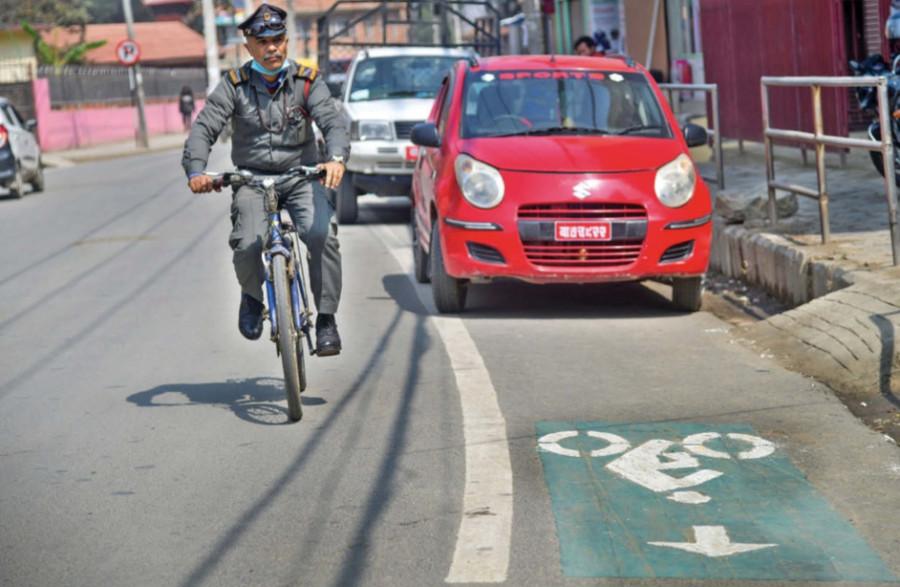Valley
Only cycle lanes are not enough, stakeholders say
They want Department of Roads to make the Valley’s roads more cycle-friendly but it is reluctant to do so.
Anup Ojha
Last week Lalitpur Metropolitan City wrote to the Department of Roads asking it for permission to mark the service lane on the eight-lane Ring Road as a cycle lane.
This is the second time that Lalitpur Metropolitan City has asked the department for such a permission.
“Earlier too the department didn't reply to our letter,” said Chiribabhu Maharjan, the mayor.
Maharjan is sceptical about getting approval from the Department of Roads, as the department had shown little concern when the City started its drive to make the roads of Lalitpur Metropolitan City cycle friendly.
Maharjan is right about the department’s reservations.
Arjun Jung Thapa, recently appointed Director General at the Department says that it’s useless making cycle lanes.
Referring to the 3.1 km cycle lane that the department marked on the Maitighar-Tinkune road in Kathmandu Metropolitan City he said, “The city made the cycle lane but nobody uses it. There is no culture of following the lane discipline.”
Local governments do not have the authority to work roads that are more than eight metres wide.
Lalitpur Metropolitan City has been actively working to make its roads friendly for cyclists and has so far painted 22 km of roads with cycle lanes starting with a stretch from Kupondole to Mangalbazar in 2019.
Of the 10.5 km section of the Ring Road between Koteshwor and Kalanki, 7.9 km within Lalitpur Metropolitan City.
“As we are working to make this city cycle friendly,” said Maharjan. “Once we get approval, we will soon start painting the roads.”
Although many have welcomed the city’s drive towards promoting cycling, few others had criticized the city for only marking cycle lanes in the inner roads where even two vehicles even can’t pass properly and therefore the road section can’t accommodate cyclists and motorists at the same time.
Mayor Maharjan, however, defends such criticisms.
“As we are into making an eco-friendly smart city, making cycle lanes will give confidence to more cyclists to ride on the road, said Maharjan. “We are also working for cyclists’ safety,”
But the local government alone cannot promote cycling, according to traffic police and other experts.
Instead, a whole eco-system needs to be developed, they say while welcoming the efforts of Lalitpur Metropolitan City.
“Just painting the lanes with a cycle logo does not make sense,” said Senior Superintendent of Police Janak Bhattarai, also the chief of the Kathmandu Valley Traffic Police Division. “There must be a system and for this the Department of Roads should work to make new infrastructures.”
Urban designers too agree that it is the responsibility of the department to make cycle friendly roads.
“It seems that those engineers at the Roads Department didn’t read about ‘people centric’ design,” said Saurav Dhakal.
Despite the criticisms against the Department of Roads, whatever little has been done cycle friendly roads already has had an impact, according research.
There were 179 cyclists riding in the Kupondole-Jawalakhel section in morning peak hours in 2019 but after the new cycle lane was marked, in 2020 there were 275 cyclists at the same hours, an increase of about 55 percent, according to research by Nepal Cycle Society .
“We are at the preliminary phase,” said Kishore Thapa, urban planner and former government secretary. “The cycle lanes will create awareness regarding cycling, this will be working as guidelines for cyclists as the number of cyclists are big.”
Meanwhile, the traffic police also welcome the drive of the Lalitpur Metropolitan City but it says there must be standard measures in making the lanes.
But the primary responsibility is of the Department of Roads, said Bhattarai, the traffic police chief.
“The existing road structures are not cycle friendly, DoR should make separate cycle lanes where other vehicles can’t move so that riders can feel safer,” said Bhattarai.
Cyclists give the example of the Maitighar-Tinkune road not being cycle friendly despite there being a cycle lane.
“The cycle lane here has been encroached by road infrastructures such as benches, and it’s not smooth and regular,” said Som Rana Urban Designer and vice-president of Nepal Cycle Society.
Promoting cycling would help in traffic congestion too.
“If the government could promote cycling that would be helpful to reduce the present traffic problem to some extent,” said Bhattarai.




 18.12°C Kathmandu
18.12°C Kathmandu.jpg)










